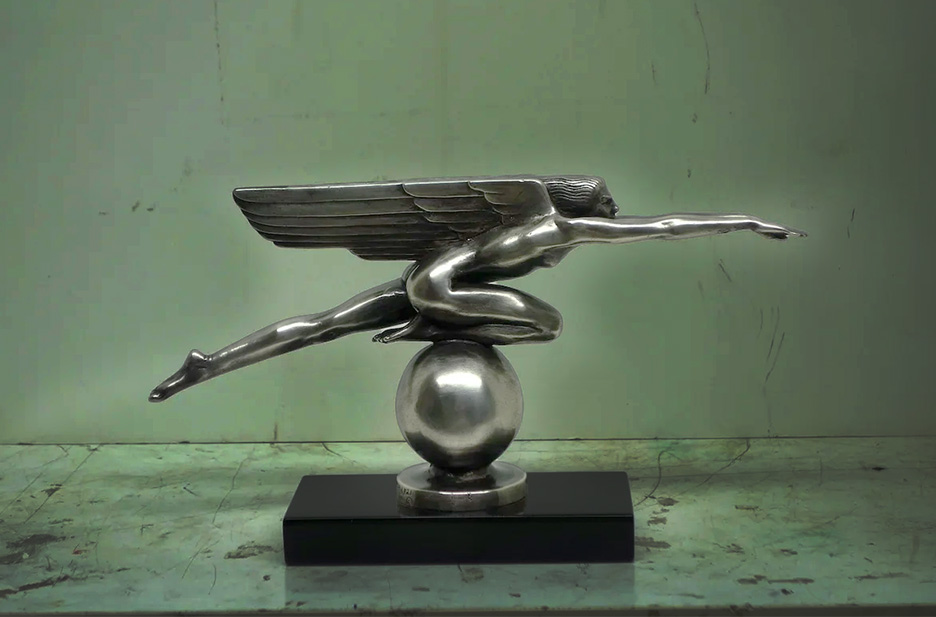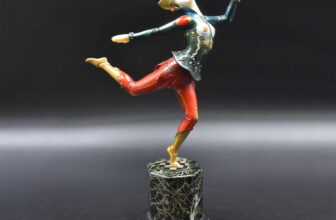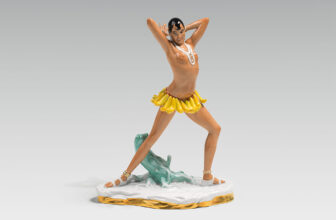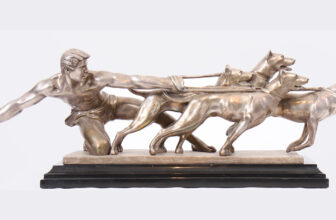
What are Frishmuth’s Famous Art Deco Sculptures
In the golden haze of the early 20th century, amid the jazz-infused rhythms and the architectural transformation of skylines, a quiet revolution was happening in art studios across America. While the world admired bold new styles emerging in Paris and New York, one woman stood out in her command of grace, movement, and femininity , not with brush or camera, but with bronze. Her name was Harriet Whitney Frishmuth, and her legacy lives on in the sinuous, dancing lines of her Art Deco sculptures.
Who Was Harriet Whitney Frishmuth?
Born on September 17, 1880, in Philadelphia, Pennsylvania, Harriet Whitney Frishmuth emerged during a time when the art world was dominated by men. Yet she carved a niche for herself , quite literally , in sculpture. Raised in a cultured household and educated abroad in Europe, she received training at the Académie Colarossi in Paris and also studied with Auguste Rodin, one of the most revered sculptors in history. This European grounding in classical form and anatomical precision would later inform her iconic American works.
Returning to the United States, Frishmuth furthered her education at the Art Students League of New York, and her career began to blossom. But it was in the 1910s and 1920s, the height of the Art Deco period, that she found her true artistic voice.
The Essence of Art Deco in Sculpture
Before delving into Frishmuth’s work, it’s important to understand Art Deco as a movement. Originating in the 1920s, it celebrated modernity, luxury, glamour, and geometric elegance. In sculpture, Art Deco emphasized streamlined forms, stylized beauty, and idealized motion.
Frishmuth’s works embodied all these qualities. But unlike some contemporaries whose figures could seem stiff or overly ornamental, her bronzes radiated a kind of organic sensuality , graceful, athletic, and alive. Her female forms didn’t just pose; they danced, leapt, and stretched toward the sky.
What Is Harriet Whitney Frishmuth Known For?
Harriet Whitney Frishmuth is best known for her elegant bronzes of female figures, often caught mid-motion. These sculptures are celebrated for their lyrical quality, capturing fleeting moments , a woman stretching in the morning sun, a dancer twirling in the wind, or a nymph lost in a daydream.
Her art frequently merged the physicality of dance and athleticism with the refined aesthetic of Art Deco. Her most famous pieces are not merely decorative but evoke emotion, vitality, and rhythm. Many of her models were professional dancers, particularly from New York’s Fokine Ballet, and this lends authenticity and grace to her figures.
Frishmuth’s Most Famous Art Deco Sculptures
Several works define Frishmuth’s legacy and are prime examples of Art Deco sculpture:
1. “The Vine” (1923)
Perhaps her most iconic sculpture, The Vine is a tour de force of Art Deco elegance. A nude female figure, caught in a moment of dance, stretches upward while standing on one foot, her arms lifted in a graceful arc. The tension between power and delicacy in the sculpture is mesmerizing. The figure seems to defy gravity.
The Vine is not just a sculpture; it is a celebration of movement and womanhood. The Art Deco influence is visible in the elongated lines, stylized hair, and clean, flowing rhythm.
2. “Crest of the Wave” (1925)
Another breathtaking piece, Crest of the Wave features a female nude poised in a dramatic leap, her body taut with energy, as if she’s riding a surge of water. The wave motif is a nod to natural forces, a recurring theme in Deco, and the streamlined pose captures the modern fascination with dynamism.
3. “Desha” (1927)
Named after dancer Desha Delteil, this smaller bronze study is a perfect blend of muse and artist. The sculpture shows a lithe figure in a poised pose, her body in gentle curve, exuding serenity and tension. It’s less flamboyant than The Vine, but no less captivating.
4. “Play Days” (1926)
In Play Days, a young girl is seen with arms raised, almost childlike in abandon. The work’s theme of freedom and innocence contrasts with the more sensual adult figures, revealing Frishmuth’s range.
How Did Harriet Whitney Frishmuth Create Her Art Deco Sculptures?
Frishmuth was known for her meticulous process. She would begin with live models, often dancers, and study their form and movement carefully. Her preferred medium was clay for the initial model, which allowed for fluid manipulation. From there, she cast her works in bronze, using the lost-wax process , a traditional but highly detailed method of casting.
Her background in anatomy , she had studied medical dissections in Paris , gave her sculptures a realism and accuracy that elevated them above mere decorative art. At the same time, her artistic eye added grace and emotion.
She often collaborated with Roman Bronze Works, one of the most prestigious foundries in New York at the time, known for their high-quality bronze casting. The rich, warm patina of her bronzes is another hallmark of her work , each finish carefully chosen to complement the figure’s mood and setting.
Where Can You Find Frishmuth’s Sculptures Today?
Harriet Whitney Frishmuth’s sculptures are prized by collectors and museums alike. Though many of her bronzes were editions , often limited , their exquisite quality ensures they are rarely found without significant effort or investment.
Some of the most notable public and private collections of her work include:
1. The Metropolitan Museum of Art – New York City
The Met holds several examples of Frishmuth’s smaller bronzes, showcasing her skill in intimate scale.
2. Brookgreen Gardens – South Carolina
This outdoor sculpture garden and wildlife preserve has one of the largest collections of American figurative sculpture and is home to The Vine among others.
3. Smithsonian American Art Museum – Washington, D.C.
Frishmuth’s contributions to American sculpture are well-represented in the Smithsonian’s holdings.
4. Museum of Fine Arts, Houston
Several Frishmuth works are part of their decorative arts and sculpture collections.
5. Cleveland Museum of Art
Her sculptures occasionally feature in exhibitions on American modernism and Art Deco.
Additionally, many of her sculptures are held in private collections and appear in high-profile auctions, often fetching six-figure sums.
How Much Are Harriet Whitney Frishmuth’s Sculptures Worth?
As of recent years, the market for Harriet Whitney Frishmuth’s sculptures has been very strong, driven by increased appreciation for early 20th-century American women artists and the perennial allure of Art Deco.
Some notable prices:
The Vine has sold for anywhere from $80,000 to over $200,000, depending on size and condition.
Smaller bronzes like Desha and Play Days typically sell in the $20,000 to $60,000 range.
Rare or unique casts, especially with original patinas or signed by Frishmuth, can command premium prices.
Auction houses such as Sotheby’s, Christie’s, and Bonhams frequently feature her work in American art and sculpture sales.
Collectors value not only the aesthetic beauty but also the historical importance of her work. Frishmuth’s name carries significant weight in both Art Deco and American art circles.
Harriet Frishmuth Legacy and Recognition
Frishmuth’s influence was not confined to sculpture alone. She broke barriers for women artists, earning numerous awards and being made a full academician at the National Academy of Design , a rare honor at the time.
She was also a founding member of the National Sculpture Society and received praise for her technical mastery and creative vision throughout her career. Her work graced public fountains, gardens, and elite salons, becoming a symbol of beauty in the American urban and domestic landscape.
Even today, her sculptures are widely exhibited and studied as exemplary of female representation in early modern art, as well as for their technical and stylistic mastery.
A Story in Bronze: The Spirit of Frishmuth
Harriet Whitney Frishmuth’s work is not merely a footnote in Art Deco or American art history. It is a lyrical testament to strength, elegance, and female expression, cast forever in bronze.
Her sculptures invite the viewer to witness not just the form of a woman, but the essence of her spirit , the freedom of movement, the joy of dance, and the power of poise.
At a time when women were fighting for autonomy in society and the arts, Frishmuth didn’t just join the fight , she sculpted it into existence.
Harriet Whitney Frishmuth was more than a sculptor of beautiful women. She was a pioneer in Art Deco sculpture, a master technician, and a true artist who understood movement, emotion, and form like few others.
Her most famous Art Deco sculptures , The Vine, Crest of the Wave, Desha, and Play Days , continue to capture imaginations nearly a century later. Created through classical methods but infused with modern flair, her bronzes embody both timeless beauty and the spirit of a changing age.
Whether displayed in a museum, a garden, or a collector’s home, her sculptures are not just objects , they are stories of grace, frozen mid-motion, dancing across generations. image/ tattiartconservation




